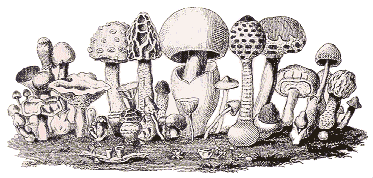"Now of all the hopeless things to draw, I should think the very worst is a fine, fat fungus", Beatrix Potter
The story of Beatrix Potter's fascination with fungi and how it led to her mastering names and species and finally to scientific discovery has become a forgotten tale.
The story begins in 1888 when Beatrix, aged 22 began drawing fungi. She had had little formal training in art but had a compulsion to draw - "I must draw - however poor the result" - and everything that interested her was recorded.
Beatrix, soon realized that she needed to know the names and species of the specimens she was collecting and painting. She turned for guidance to Charles McIntosh who had been the postman at Dalguise in Perthshire where the Potters had their summer holidays. McIntosh had become a noted naturalist and had been made an Associate Member of the Perthshire Society for Natural Science.
By 1896 Beatrix had progressed far beyond finding fungi interesting to draw. She began to have ideas that differed from the official line on fungal reproduction and also to form a theory on the nature of lichens. To publicise her findings she wrote a paper, 'The Germination of the Spores of Agaricineae' which was presented at a meeting of the Linnean Society of London on 1st April, 1897. Being a woman, Beatrix was not allowed to read it in person or attend the meeting. A Mr. Massee, the 'one gentleman at Kew' who believed in her, read it on her behalf. The recordings of the proceedings give no clues as to whether the paper was read, or just presented by title. Mr. Massee told Beatrix that it had been well received but it was considered more work was needed. No more was heard of it and the paper has disappeared.
After so much work, this casual dismissal must have been a severe disappointment. Beatrix went on collecting and drawing fungi for a few more years, but the zest of discovery had gone and gradually other interests took over, including the idea of turning some of the picture letters she had written to children into little books. 'The Tale of Peter Rabbit' was published in 1902.
Beatrix’s drawings of over 300 fungi were stored away, quietly forgotten but after her death, as was her wish, the watercolours were given to the Armitt Library and Museum. This Collection is unique. Beatrix’s great achievement is that she makes us see fungi as though we’ve never seen them before. Beautiful compositions that draw the eye, three dimensional with a delicate texture, finely coloured yet so accurate that experts can identify them without difficulty.
Here at the Armitt we want to make this Collection better known and are currently creating an illustrated catalogue that will be made available via the WWW and as a CD. To set the images in their proper context we would like to place photographs of fungi in their natural habitat side by side with the original drawings. Consequently I am appealing to members of the North West Fungus Group for help. A full list of the drawings we are seeking companion photographs for is available by contacting the Curator or at our web site, www.armitt.com. An abbreviated version of the list, concentrating on the Cumbrian specimens, can be found below (Not included here. Ed.). If possible it would be good to collect photographs of fungi near the original locations but I would be very happy to receive photographs of relevant fungi from any area in the North West. Images can be sent as photographs which will be scanned and returned or as digital images. For Further information please contact Lynda Powell, Curator, Armitt Library and Museum Centre, Rydal Road, Ambleside, Cumbria, LA22 9BL, 015394 31212 or mail@armitttrust.fsbusiness.co.uk
Bibliography
Beatrix Potter; The Unknown Years, by Elizabeth Battrick (available from Ambleside Museum and Armitt Library), 1999.
The Linnean, vol 16, number 1, January 2000.
A Victorian Naturalist Beatrix Potter’s Drawings from the Armitt Collection, Jay, Noble, Stevenson Hobbs, 1992.
